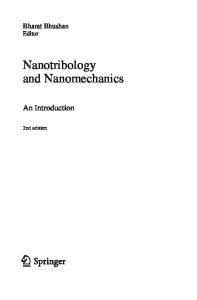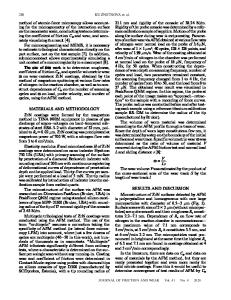Friction and Wear on the Atomic Scale
friction Friction is an old subject of research: the empirical da Vinci–Amontons laws are common knowledge. Macroscopic experiments systematically performed by the school of Bowden and Tabor have revealed that macroscopic friction can be related to the co
- PDF / 8,538,455 Bytes
- 30 Pages / 547.146 x 686 pts Page_size
- 36 Downloads / 369 Views
20.1 Friction Force Microscopy in Ultra-High Vacuum ........................... 20.1.1 Friction Force Microscopy .............. 20.1.2 Force Calibration .......................... 20.1.3 The Ultra-high Vacuum Environment ............................... 20.1.4 A Typical Microscope in UHV ........... 20.2 The Tomlinson Model ............................ 20.2.1 One-dimensional Tomlinson Model 20.2.2 Two-dimensional Tomlinson Model 20.2.3 Friction Between Atomically Flat Surfaces ...
632 632 632 635 635 636 636 637 637
20.3 Friction Experiments on Atomic Scale ..... 638 20.3.1 Anisotropy of Friction ................... 642 20.4 Thermal Effects on Atomic Friction ......... 20.4.1 The Tomlinson Model at Finite Temperature ................... 20.4.2 Velocity Dependence of Friction ..... 20.4.3 Temperature Dependence of Friction ................................... 20.5 Geometry Effects in Nanocontacts .......... 20.5.1 Continuum Mechanics of Single Asperities ....................... 20.5.2 Load Dependence of Friction ......... 20.5.3 Estimation of the Contact Area .......
642 642 644 645 646 646 647 647
20.6 Wear on the Atomic Scale ...................... 649 20.6.1 Abrasive Wear on the Atomic Scale . 649 20.6.2 Wear Contribution to Friction......... 650 20.7 Molecular Dynamics Simulations of Atomic Friction and Wear .................. 651 20.7.1 Molecular Dynamics Simulation of Friction Processes ..................... 651 20.7.2 Molecular Dynamics Simulations of Abrasive Wear .......................... 652 20.8 Energy Dissipation in Noncontact Atomic Force Microscopy .. 654 20.9 Conclusion ........................................... 656 References .................................................. 657 microscopy, which may become an important complementary tool for the study of mechanical dissipation in nanoscopic devices.
Part C 20
Friction is an old subject of research: the empirical da Vinci–Amontons laws are common knowledge. Macroscopic experiments systematically performed by the school of Bowden and Tabor have revealed that macroscopic friction can be related to the collective action of small asperities. During the last 15 years, experiments performed with the atomic force microscope gave new insight into the physics of single asperities sliding over surfaces. This development, together with complementary experiments by means of surface force apparatus and quartz microbalance, established the new field of nanotribology. At the same time, increasing computing power allowed for the simulation of the processes in sliding contacts consisting of several hundred atoms. It became clear that atomic processes cannot be neglected in the interpretation of nanotribology experiments. Experiments on even well-defined surfaces directly revealed atomic structures in friction forces. This chapter will describe friction force microscopy experiments that reveal, more or less directly, atomic processes in the sliding contact. We will begin by introducing friction force microscopy, including the calibration of cantilever force sen
Data Loading...











